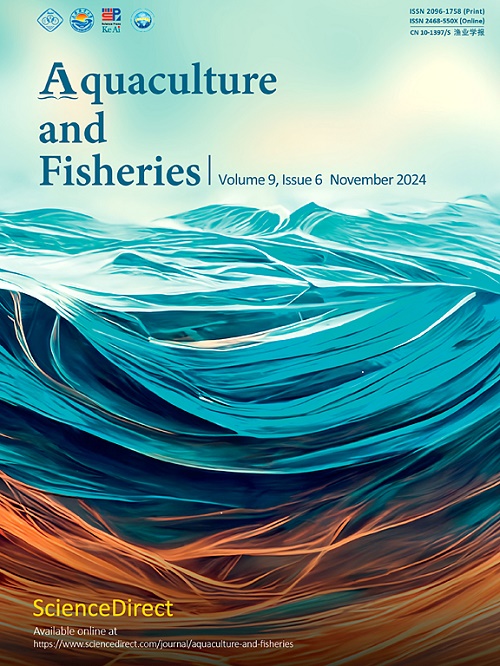泰国驯化亚洲鲈鱼生长的遗传多样性、遗传率和估计育种值
Q1 Agricultural and Biological Sciences
引用次数: 0
摘要
为建立新的养殖计划,对亚洲海鲈(Lates calcarifer) 5个驯化种群和2个商业种群的遗传多样性进行了研究。基于微卫星多态性的遗传多样性处于中等水平。每个位点等位基因数(NA)为3.429 ~ 11.571个。观察杂合度(Ho)和期望杂合度(He)分别为0.416 ~ 0.772和0.423 ~ 0.805。FST和遗传异质性分析显示,大多数两两比较的遗传差异显著(P <;0.001)。居群间遗传距离为0.000 ~ 0.703。系统发育分析将检验群体划分为两个遗传种群;A:茶城骚2号渔场、松卡渔场、庄渔场;B: 1号商业渔场(普吉岛)、2号商业渔场(茶城骚)、1号渔场和甲米渔场。基础种群(G0, 51个家系)是由这些创始种群之间的杂交建立的。在孵化后519天(dph,平均体重= 616.64±266.80 g, N = 1655),评估G0家系的生长遗传力和估计育种值(ebv)。本研究中钙化l生长的遗传力(h2)为0.386±0.020。加性遗传变异系数为28%,表明该群体具有较高的遗传改良潜力。ebv的分布在家族间和家族内均表现出较大的变异。显示高ebv的鱼(satps - dof - g0 - hebvs)与系统发育分支a聚集在一起,而satps - dof - g0 - lebvs组在系统发育上被分配到进化分支b。以+1SD标准进行遗传选择,预计每代遗传增益为28.5%。遗传多样性和ebv估计的信息可以有效地实施我们正在进行的钙化油菜育种计划。本文章由计算机程序翻译,如有差异,请以英文原文为准。
Genetic diversity, heritability, and estimated breeding values for growth of domesticated Asian seabass Lates calcarifer from Thailand
To establish a new breeding program, genetic diversity of five domesticated populations and two commercial stocks of Asian seabass (Lates calcarifer) were examined. Moderate levels of genetic diversity based on microsatellite polymorphism were found. The number of alleles per locus (NA) was 3.429–11.571. Observed (Ho) and expected (He) heterozygosities were 0.416–0.772 and 0.423–0.805. FST and genetic heterogeneity analysis revealed significant genetic differences of most pairwise comparisons (P < 0.001). Genetic distance between populations was 0.000–0.703. Phylogenetic analysis divided examined populations to two genetic stocks; A: DOF-Chachoengsao 2, DOF-Songkhla, and DOF-Trang and B: Commercial Farm 1 (Phuket) and Commercial Farm 2 (Chachengsao), DOF-Chachoengsao 1 and DOF-Krabi. The base population (G0, 51 families) was established from crosses between these founder populations. Heritability and estimated breeding values (EBVs) for growth in G0 families were evaluated at 519 day post hatch (dph, mean body weight = 616.64 ± 266.80 g, N = 1655). The heritability (h2) for growth of L. calcarifer in this study was 0.386 ± 0.020. The additive genetic coefficient of variation was 28% indicating high potential of genetic improvement for growth in this population. The distribution of EBVs showed high variation both between and within families. Fish exhibiting high EBVs (SATREPS-DOF-G0-hEBVs) clustered with a phylogenetic clade A while the SATREPS-DOF-G0-lEBVs group was phylogenetically allocated to clade B. Genetic selection with +1SD criteria is expected to achieve genetic gain of 28.5% per generation. The information on genetic diversity and EBVs estimates allows efficient implementation of our ongoing breeding program of L. calcarifer.
求助全文
通过发布文献求助,成功后即可免费获取论文全文。
去求助
来源期刊

Aquaculture and Fisheries
Agricultural and Biological Sciences-Aquatic Science
CiteScore
7.50
自引率
0.00%
发文量
54
审稿时长
48 days
期刊介绍:
 求助内容:
求助内容: 应助结果提醒方式:
应助结果提醒方式:


